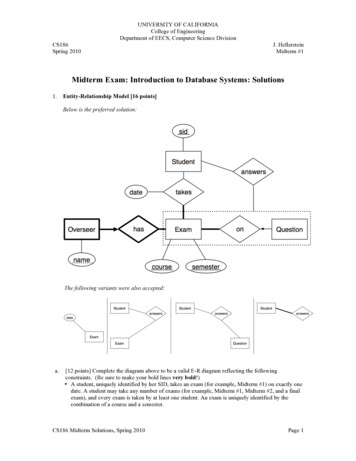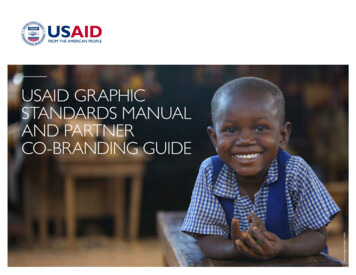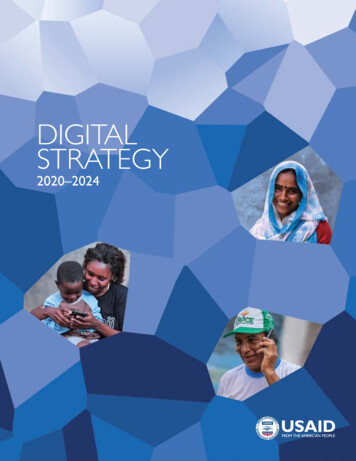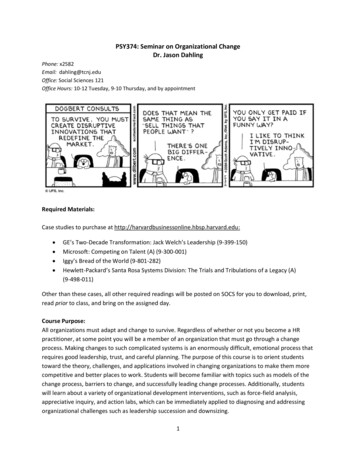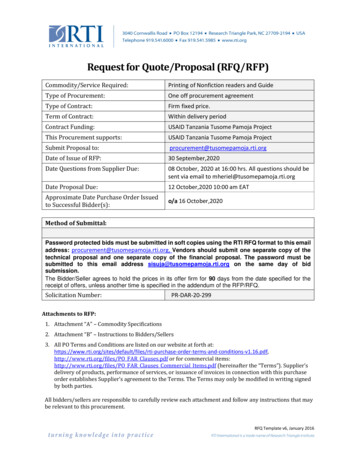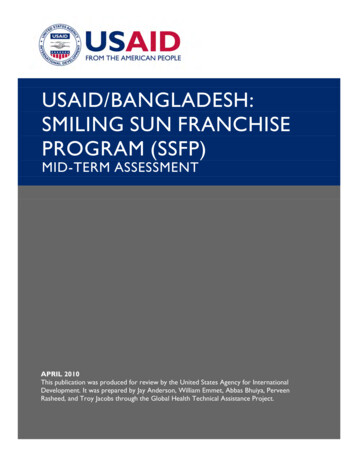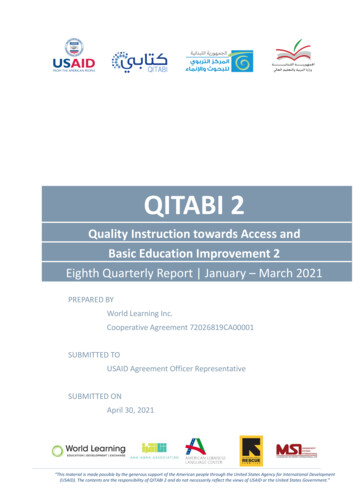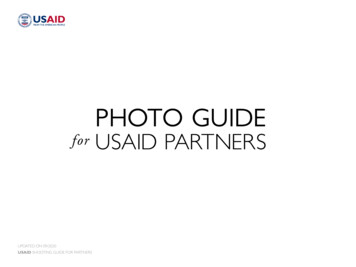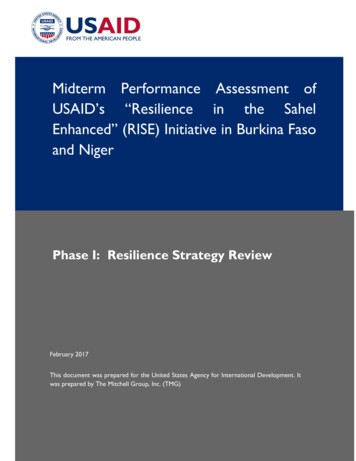
Transcription
Midterm Performance Assessment ofUSAID’s “Resilience in the SahelEnhanced” (RISE) Initiative in Burkina Fasoand NigerPhase I: Resilience Strategy ReviewFebruary 2017This document was prepared for the United States Agency for International Development. Itwas prepared by The Mitchell Group, Inc. (TMG)
This document was prepared for the United States Agency for International Development – SahelRegional Mission.Prepared by:The Mitchell Group, Inc.Dr. Evan Scott Thomas, Director of Monitoring, Evaluation, and Learning (MEL), TMGDr. John McCauley, Principal InvestigatorTrey Billing, Research AssociateAndrew Lugg, Research AssociatePrincipal contacts:Dr. Evan Scott Thomas, MEL Director, TMG, Washington, DCEmail: scottt@the-mitchellgroup.comDr. John McCauley, Principal Investigator, TMG, Washington, DCEmail: johnm@the-mitchellgroup.comImplemented by:The Mitchell Group, Inc. (TMG)1816 11th Street, NWWashington, DC 20001Tel: 202-745-1919
Midterm PerformanceAssessment of USAID’s“Resilience in the SahelEnhanced” (RISE) Initiativein Burkina Faso and NigerPhase I: Resilience Strategy ReviewFebruary 2017 (Revised April 2017)DISCLAIMERThe views expressed in this publication do not necessarily reflect the views of the United StatesAgency for International Development or the United States Government.
This page is intentionally left blank.
Table of ContentsLIST OF ACRONYMS. vEXECUTIVE SUMMARY . vi1.INTRODUCTION . 12.STATE OF THE LITERATURE ON RESILIENCE . 33.2.1.Conceptual Foundations . 32.2.Related Concepts from Across Disciplines . 102.3.Resilience Defined in Practice . 122.4.The Sahelian Context . 182.5.The Institutional Context in Burkina Faso and Niger . 212.6.Value Added from Resilience Enhancement Initiatives . 22RESILIENCE PROGRAM SUMMARIES . 253.1.Resilience in the Sahel Enhanced (RISE) Programming . 253.2.Ethiopia Resilience Programming . 313.3.Kenya Resilience Programming . 343.4.Resilience Programming in other Country Contexts . 384.IDEAS FOR CONSIDERATION . 425.CONCLUSION . 46REFERENCES . 49ANNEX . 60
List of AcronymsAPHIA: Aids, Population, and Health Integrated Assistance (Kenya)AHADI: Agile Harmonized Assistance for Developed Institutions (Kenya)ASAL: Arid and Semi-Arid LandsCBNRM: Community-Based Natural Resource ManagementCAHW: Community Animal Health WorkersCCT: Conditional Cash TransferCDAP: Community Development and Action Plans (Kenya)CFW: Cash for WorkCLP: Chars Livelihoods Program (Bangladesh)CRS: Catholic Relief ServicesDCA: Development Credit AuthorityDFID: Department for International Development (United Kingdom)DRR: Disaster Risk ReductionECHO: European Civil Protection and Humanitarian Aid OperationsEDE: Ending Drought Emergencies (Kenya)ENGINE: Empowering New Generations to Improve Nutrition and Economic OpportunitiesGID: Gesellschaft für Internationale Zusammenarbeit (Germany)GFDRR: Global Facility for Disaster Reduction and RecoveryGoE: Government of EthiopiaGoK: Government of KenyaGRAD: Graduation with Resilience to Achieve Sustainable Development (Ethiopia)GRP: Global Resilience PartnershipGTZ: Gesellschaft für Technische Zusammenarbeit (Germany)HKI: Hellen Keller InternationalIDT: Inpres Des Tertinggal (Indonesia)IMARSHA: Integrated Marginal Arid Regions Innovative Socialized Health ApproachKAVES: Kenya Agriculture Value Chain EnterprisesLEAP: Linking Financial & Social Capital to Enhance Resilience of Agropastoral CommunitiesLEARN: Localized Emergency Assistance Response in NigerMNCH: Maternal, Newborn, and Child Health program (Kenya)NDMA: National Drought Management Authority (Kenya)NRT: Northern Rangelands TrustPLI: Pastoralist Livelihoods Initiative (Ethiopia)
PSNP: Productive Safety Net Program (Ethiopia)PREG: Partnership for Resilience and Economic Growth ProgramPRIME: The Pastoralist Areas Resilience Improvement and Market Expansion (Ethiopia)REGAL-AG: Resilience and Economic Growth in Arid Lands – Accelerated Growth (Kenya)REGAL-ER: Resilience and Economic Growth in Arid Lands – Improving Resilience (Kenya)RFM: Risk Financing MechanismRISE: Resilience in the Sahel EnhancedTMG: The Mitchell GroupTUP: Targeting the Ultra-Poor (Bangladesh)USAID: United States Agency for International DevelopmentWASH:Water,Sanitation,viiandHygiene
Executive SummaryIn November 2016, USAID commissioned The Mitchell Group, Inc. (TMG), to conduct anacademic literature review on the state-of-the-art in resilience enhancement and to relate thosefindings to the interventions of RISE partners, taking into consideration the particularities of theSahel context. This review constitutes one phase of the midterm performance assessment ofthe Resilience in the Sahel Enhanced (RISE) initiative underway in Burkina Faso and Niger. TheRISE initiative aims to improve the resilience of households and communities in vulnerable areasof Burkina Faso and Niger. The purpose of Phase I of the assessment is to draw attention to thekey findings and current trends in the academic literature related to resilience enhancement. Itsets a foundation, along with the field component, for answering the following questions:1. Can RISE interventions be altered to address gaps and capitalize on lessons from resilienceprograms implemented in other contexts?2. To what extent is the RISE technical theory of change valid?3. To what extent is the RISE operational theory of change valid?4. What activities have RISE partners focused on to balance the different levels of vulnerability,and to ensure complementary improvements?5. To what extent is RISE making progress toward its performance goals?6. To what extent are the changes promoted by RISE sustainable?To create a basis for the fieldwork component of the study and to serve as a useful resourcefor scholars and practitioners of resilience enhancement, this review includes three keycomponents: First, the review examines the state of the literature on resilience. It describes a union ofecological and social factors, as well as the importance of absorptive, adaptive, andtransformative capacities. However, it also highlights complexities and disagreements in theconceptualization of resilience. This section underscores the importance of governmentsand institutions in addressing resilience, and the particular challenges to resilience in theSahel. Second, the review covers a number of resilience-related programs, including the RISEprogram and associated DFAPs, related resilience programs in Ethiopia and Kenya, andresilience enhancing programs elsewhere. This section notes the programs that excel orface shortcomings in addressing the key capacities of absorbing, adapting, and transforming;and it draws attention to the importance of sociocultural differences. Third, the review outlines a set of ten ideas for consideration. These ideas build on trendsin the literature and in resilience programming; they are intended to encourageexperimentation in resilience programming. Ideas for consideration include the following:
1) add emphasis to transformative capacities; 2) expand and build new resource-sharingnorms into social protection programming; 3) target shocks and stresses in distinct, tailoredways; 4) engage formally with multiple levels of government; 5) use resilience tocomplement other effective programs; 6) facilitate access to natural resources, beingmindful of cultural norms; 7) capitalize formally on migratory networks; 8) generate explicitlinks between skills and opportunities for youth; 9) consider targeting precisesocioeconomic strata; and 10) work formally with religious and cultural leaders.ix
1. IntroductionResilience in the face of crisis, shocks, and stresses has long been recognized as a critical aspectof overcoming extreme poverty. The World Bank, for example, called resilience a “highpriority” over 30 years ago (World Bank 1985), and development economists noted theimportance of poor households cultivating resilience against setbacks even earlier (see Saeed1982). Farmers’ “responsiveness to drought” and “adjustments to risk” were common themesamong scholars in the 1970s (see Hankins 1974; Jodha 1978). Today, attention to resilience inthe poorest parts of the world has only increased, as threats from conflict, climate change, andresource shortfalls frequently put vulnerable people at risk of backsliding below adequate levelsof subsistence.This review addresses the current state of the literature on resilience. It is a part of themidterm performance assessment of the Resilience in the Sahel Enhanced (RISE) initiative, aUSAID-funded initiative aiming to improve the resilience of households and communities invulnerable areas of Burkina Faso and Niger. Resilience is a complex, multi-faceted concept thatimplicates numerous fields of study and development priorities; for its part, USAID definesresilience as “the capacity of affected people, households, communities, countries and systemsto mitigate, adapt to, and recover from shocks and stresses in a manner that reduces chronicvulnerability and facilitates inclusive growth.” In reviewing and drawing insights from theacademic literature, we aim to distill some of the central lessons regarding this complexconcept, such that USAID and other aid organizations might maintain an updated and diverseportfolio of information that will ultimately help in devising the most appropriate programs toaid the chronically vulnerable.The review includes three key components. First, we conducted a broad review of availableliterature on the state-of-the-art of resilience activities from around the world, paying specialattention to the literature available on the Sahel. We consider the foundations of resilience andthe diverse set of approaches to improving resilience from across academic disciplines, buildingon the foundation currently employed by USAID that emphasizes the importance of addressingthe absorptive, adaptive, and transformative capacities of vulnerable people. We consider howresilience is defined and addressed by various international development institutions, and wetake note of the features of the Sahel that may impact resilience programming in that particularregion. We end the section with a consideration of the value added from resilienceenhancement initiatives.Second, we conducted a comparative summary of resilience-related programs from aroundAfrica and the world. Doing so provides insight into resilience programs and strategies thatcould potentially be adopted in the Sahel; it also helps to illustrate how contextual factors mightfacilitate some approaches and undermine others. We begin with an overview of the RISEassociated programs, of which this assessment constitutes a part. We then outline details1
related to similar USAID-funded initiatives in Ethiopia and Kenya. We complete the section byconsidering resilience-related programs undertaken in different parts of the world. At eachstep, we emphasize the objectives and the outcomes based on evaluations and reviews.Third, we provide a set of ideas for consideration stemming from the literature. We note areasof work that could be reinforced, factors that regularly arise as important in the scholarship onresilience, and ideas that could lead to new intervention opportunities in the study region.Some may be more appropriate than others for any given context, and some may be suitablefor introduction into existing initiatives, while others may be best suited for subsequentresilience-related programming. We encourage readers to view the considerations not asnecessities for effective resilience enhancement, but rather as possibilities for creating newvalue added.Structured as such, this assessment along with the complementary field study should provideguidance for addressing questions about resilience improvement generally and about the RISEinitiative’s ongoing work more specifically. In particular, the two phases of the performanceassessment will contribute answers to the following questions.On Resilience Strategy:1. In comparing the types of interventions of RISE partners with those found in a review ofother resilience programs and of the literature on resilience, are there potential gaps in theRISE interventions, either in terms of the shocks and stresses they are designed to address,interventions being pursued, or the types of resilience capacity they are designed to build?Which of these potential gaps, when contextualized to the Sahel, might the RISE partnersconsider addressing with new or revised interventions?2. To what extent is the RISE technical theory of change, as embodied in its resultsframework, valid?3. What was the basis for setting targets, and have they been adjusted based on performance?4. Is the link between project interventions (that involve the application of one or severalintegrated resilience best practices) and desired results clear?5. Is the linkage clear between project results (e.g. livelihoods, NRM, health outcomes) andstrengthened resilience capacity?6. What adjustments to the TOC might be required?7. To what extent is the RISE operational theory of change valid?8. What evidence exists that sequencing, layering and integration of humanitarian anddevelopment assistance can improve resilience outcomes and reduce overall cost of aid?9. Are RISE project interventions sequenced, layered, and integrated in an effective way?
10. What adjustments might be required to the approach?On Project Efficacy:1. What types of outcomes have the RISE partner interventions focused on in terms of theirefforts to increase resilience to shocks or stresses at community levels, or household levels,or both?a. Increases in absorptive capacity;b. Increases in adaptive capacity; and/orc. Increases in transformative capacity?d. Have those choices been planned, strategic, practical, or necessary? Why?e. To what extent have RISE partners addressed gender gaps successfully in the Sahel?2. To what extent is RISE making progress toward its performance goals?a. In what areas is it excelling and where is it struggling? Why?b. What could be changed or adjusted to enhance current successes and rectifyweaknesses in implementation?c. Are the RISE activities generally timely and effective in the employment of resources?d. Do they seem to be reaching targeted beneficiaries to an acceptable degree?e. To what extent has collaboration among stakeholders improved results andinterventions?f.How could collaboration be enhanced while not imposing undue burdens on partnersand USAID staff?3. To what extent is there evidence that changes promoted by RISE - both at the communityand system levels – are likely to be sustained beyond the life of direct program support?This review, as the first phase of the assessment, constitutes an effort to step back fromongoing USAID-funded resilience projects and to recognize key findings and current trends inthe academic literature related to resilience. It should serve as a guide for tightening theoriesof change and better connecting interventions to outcomes. It also offers an opportunity toconsider new ideas in addressing resilience concerns. The review constitutes a referencedocument on various topics, so readers might focus on the sections most relevant to their owninterests. We also urge readers to weigh the themes addressed here but also to contemplatenew and different ways in which the literature might suggest improved approaches to resilienceenhancement.3
2. State of the Literature on ResilienceThis section provides an overview of the academic literature on resilience. We draw fromacross disciplines and aim to complement the advances that USAID has already made inconstructing a rigorous and testable conceptualization of resilience as a development initiative.The section begins by outlining the conceptual foundations of resilience. We then explorerelated concepts from across disciplines. Resilience enhancement may, in a broad sense, beaddressed in a variety of ways, sometimes using different language or from angles not typicallyassociated with resilience; by exploring these related concepts, we might bring new ideas to theevolution of initiatives like RISE. The third component of this section considers resilience inpractice, as implemented by international development institutions, to understand how theconcept is treated by different organizations, how it is defined in the course of developmentinitiatives, and how distinct priorities might be woven into a resilience enhancement approach.Fourth, insofar as the RISE initiative is based in the Sahel, we review some common themesfrom the literature regarding the key features of the Sahel region, some fairly unique andseveral posing critical challenges for resilience enhancement work. Finally, this section outlinesthe value added by incorporating resilience-related concerns into development work, asoutlined in the literature.2.1.Conceptual FoundationsResilience as a scientific concept has been applied broadly in both the natural and social sciences,as well as in their integration. A starting point in physics can help to elucidate contemporaryefforts to enhance resilience among vulnerable people. In that discipline, resilience refers to“the capacity of a material to absorb energy when it is deformed elastically and then, uponunloading, to have this energy recovered” (Callister and Rethwisch 2012: 216, cited in Béné etal. 2016). A common example would be the expected capacity of a bridge, after experiencingsome physical shock or stress, to return quickly to its normal, equilibrium state.Usage of resilience as a concept in physics was extended by ecologists in the 1960s and 1970sto applications regarding ecological systems. Holling (1973: 17) provides perhaps the mostwidely used definition of resilience in this literature, defining the concept as “a measure of theability of these [eco] systems to absorb changes of state variables, driving variables, andparameters, and to still persist.” Note that in this conceptualization, it is not the return to anindividual equilibrium state that is crucial. Instead, the system must be able to withstand a shockor stress and to maintain its given function (Martin-Breen and Anderies 2011).Resilience can be extended further to include the interaction between ecological and socialsystems, in a manner that addresses the challenges facing vulnerable populations. This morecomplex conceptualization – referred to as social-ecological resilience or resilience in complexadaptive systems – may be defined as “the ability to withstand, recover from, and reorganize in
response to crises” while retaining function, if not the original system structure (Martin-Breenand Anderies 2011: 7). The key, then, is the addition of adaptation and transformation.Conceptualized in this manner, resilience is an ‘emergent property’ that arises as a function ofthree different capacities. First, absorptive capacity of a system refers to the “various copingstrategies by which its members [units] moderate or buffer the impacts of shocks on theirlivelihoods and basic needs” (Bene et al. 2015). For example, in the context of a household,this may mean consumption smoothing of grain stocks in response to a severe drought (e.g.Kazianga and Udry 2004). In essence, then, absorptive capacity can be thought of as the abilityto ensure adequate assets and strategies to stave off harm from minor or transitory shocks andstresses. In addition to consumption smoothing, this could involve the selling off of assets,changing spending patterns, temporary migration, utilizing social networks, or withdrawingchildren from school in order to reduce costs or increase farm-based revenue. A variety ofinterventions, ranging from institutional capacity building (e.g. Olsson et al., 2004) to earlywarning systems (Baudoin 2014) to direct cash transfers (Tumusiime, 2015) have been shownto enhance the absorptive capacities of poor households. These changes are considered ashort-term shift rather than a loss or a gain; when mapped onto the framework in Figure 1below, absorptive capacity results in persistence, given a relatively low intensity shock or stress.Second, adaptive capacity – or “the various adjustments (incremental changes) that peopleundergo in order to continue functioning without major qualitative changes in function orstructural identity” (Béné 2014: 601) – allows for incremental adjustment and flexibility inresponse to a moderately intense shock or stress. Adaptability refers here to the ability of aunit to learn and adjust its response to shocks and stresses. For example, a household mayadopt new farming techniques or diversify its livelihood activities (Headey et al. 2014); take outloans and expand its social network (Fafchamps and Lund 2003); or engage in other changes inbehavior meant to help offset the shock or stress they are currently experiencing. Adaptivemeasures typically have positive consequences, though some – such as relying on patronagenetworks – may impose costs in the short-term. Further, some of these adaptations take placethrough the independent volition of the units themselves, but those efforts are greatlyfacilitated when institutions and structures are in place that can incentivize and encourageadaptive processes. For example, an extensive literature attempts to unravel the multi-causalnature of technological adoption by farmers (e.g. Knowler and Bradshaw 2007; McCauley2003), much of it noting that human capital and institutions such as agricultural extensionservices play a key facilitative role (Rahm and Huffman 1984; Adesina et al., 2000, Zbinden andLee 2005; World Bank 2007).5
Figure 1: Resilience CapacitiesNote: Adapted from Béné et al. (2012).Finally, transformative capacity refers to the ability of units or individuals to “create afundamentally new system when ecological, economic, or social structures make the existingstructure untenable” (Walker et al. 2003: 5). This final capacity results in transformationalresponses in the context of highly intense shocks and stresses. The responses are typicallyaimed at permanently altering the system and its structure in a way that ensures the survival ofthe unit(s). For example, severe drought or conflict might push people from pastoralism intosedentary agriculture, or may escalate migration to urban centers (e.g. Lybbbert et al. 2004).Another way to think about transformability is the “capacity to cross thresholds into newdevelopment trajectories” (Folke et al. 2010). As with adaptive capacity, important institutionaland human capital requirements typically must be met in order for transformation to take place.These requirements speak to the importance of viewing resilience as more than just adequatefood supplies; they implicate community governance, instructional and literacy gains, and anumber of other potential intervention areas. Transformative capacity-building may also includesystemic reform such as policy adjustments.At least two important complications must be addressed when employing the simpleframework for resilience outlined in Figure 1. First, as USAID’s definition of resilience implies,each capacity is relevant at multiple levels – including individuals, households, communities,regions, and systems – as well as across different temporal and spatial scales (Béné et al. 2012).Second, although absorptive, adaptive, and transformative capacities appear to fall linearly on acontinuum according to shock intensity, it is critical to keep in mind that vulnerable areas areoften hit with multiple shocks and stresses simultaneously, and often at varying intensities. AsBéne et al. (2012: 23) note, “this linear interpretation is pragmatically too simplistic, as itdoes not recognize the multi-stressor nature of vulnerability – that is, the fact that manydifferent shocks and stresses combine and occur together.”Even setting aside those complications, the conceptual evolution of resilience described above isnot without dissent. Brand and Jax (2007) argue that resilience has become a boundary objectthat spans across a number of disciplines in too vague a manner; they conclude by suggesting
that resilience as applied in ecological systems must be clearly differentiated from resilience asapplied elsewhere. Others argue similarly that when applied to social problems, the ‘naturalscience roots’ of resilience become too strong, thereby missing key social dynamics like powerrelations (Cannaon and Muller-Mahn 2010; Lidskog 2001). Critically, sociocultural andsocioeconomic contexts can vary in important ways—in terms of the priority placed on familiesand communities versus individuals, for example—and to recraft livelihood patterns withoutcareful consideration of those contextual factors strikes some scholars as inappropriate andself-defeating (see Meyer 1988).In response to these critiques, four alternative conceptualizations of resilience as adevelopment goal have emerged. First, Keck and Sakdapolrak (2014) attempt to clarify socialresilience as used in the literature. Summarized in Table 1 below, they describe a typology that isclosely in keeping with the framework in Figure 1, but with an emphasis on coping capacity in theplace of absorptive capacity. In addition, however, they also explicitly integrate “insights from thesocial sciences and address questions of human agency, social practices, power relations,institutions, and discourses – facets that have been widely ignored in studies of ecologicalresilience” (Keck and Sakdapolrak 2014: 11). In doing so, they emphasize three key factors ofsocial resilience: 1) social relations and network structures; 2) institutions and power relations;and 3) knowledge and discourses.Table 1: Social Resilience CapacitiesCoping capacitiesAdaptive capacitiesTransformative capacitiesResponse to riskEx-postEx-anteEx-anteTemporal scopeShort-termLong-termLong-termLow, status quoMedium, incrementalchangeHigh, radical changeRestoration of presentlevel of well-beingSecurity of future wellbeingEnhancement of present andfuture well-beingDegree of changeOutcomeNote: Adapted from Keck and Sakdapolrak (2014)Regarding these three key factors of social resilience, the first – an emphasis on social networkstructures – highlights a tendency in the literature to view social capital as a key element in thebuilding and maintenance of resilience (e.g. Adger 2000; Adger et al. 2002; Pelling and High2005; Wolf et al. 2010; Scheffran et al. 2012). While social capital is a somewhat elastic concept(see Adler and Kwon 2002), it is typically understood as a potentially valuable resource thatindividuals can draw upon during times of stress or shock. The basic intuition is that the abilityof social units to draw on the goodwill (and assets) of their friends, families, and socialnetworks can be an important source of resilience. Furthermore, social capital that extendsbeyond immediate family or friends – e.g. bridging capital and linking capital – is thought to7
increase aggregate economic growth (Knack and Keefer (1997) and has been linked to increasesin communities’ overall resilience to shocks and stresses (e.g. Aldrich 2011, 2012).Nevertheless, social networks can at times also hinder resilience if they negatively impact theability of the units to learn, adapt, and plan for future events (Bohle 2005).The second key factor in social resilience indicates that scholars should pay close attention tohow institutions and power relations affect access to resources among the units. For example,Langridge et al (2006) attributed variation in communities’ responses to water scarcity as afunction of the historical development of institutions that control access. Thus, these scholarsemphasize that vulnerability is often not equally distributed across communities (e.g. Cannon2008). This indicates that programming meant to enhance resilience will likely have a differentialimpact on individuals based in part on how extant institutions distribute power in a givencommunity. Building resilience may thus create winners and losers, and building resilience inone area may reduce it in others (Walker and Salt 2012).The third key factor in social resilience emphasizes that the ability of social units to cope withshocks and stresses is impacted by the underlying beliefs and level of knowledge in the socialsystem (Furedi 2007; Schwarz et al 2011). Several studies show that for units to be resilientthey must perceive of themselves as resilient (Voss 2008; Marshall and Marshall 2007).Empirically, studies show that individuals who perceive of themselves as resilient are more likelyto adopt new technologies (Marshall 2010). Furthermore, individuals’ perceptions of largersocial institutions can affect resilience. One study found that farmers in NGO developmentprojects in Benin use different coping strategies, like the adoption of adva
Midterm Performance Assessment of USAID’s “Resilience in the Sahel Enhanced” (RISE) Initiative in Burkina Faso and Niger . the absorptive, adaptive, and transformative capacities of vulnerable people. We consider how resilience is defined and addressed
